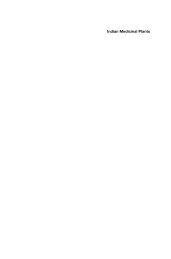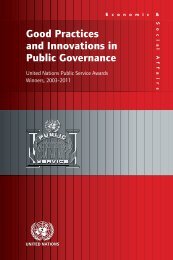a-collection-of-research-articles-on-the-medical-potential-of-cow-urine
a-collection-of-research-articles-on-the-medical-potential-of-cow-urine
a-collection-of-research-articles-on-the-medical-potential-of-cow-urine
Create successful ePaper yourself
Turn your PDF publications into a flip-book with our unique Google optimized e-Paper software.
790 E.E. Jarald et al.<br />
Downloaded by [University <str<strong>on</strong>g>of</str<strong>on</strong>g> Go<strong>the</strong>nburg] at 21:45 17 September 2015<br />
Materials and Methods<br />
Procurement <str<strong>on</strong>g>of</str<strong>on</strong>g> materials<br />
The <strong>urine</strong> <str<strong>on</strong>g>of</str<strong>on</strong>g> a 2-year-old virgin Gujarati Indian <strong>cow</strong> known<br />
as “Geer <strong>cow</strong>” was used in <strong>the</strong> study. The study was performed<br />
after getting a certificate from <strong>the</strong> veterinary doctor<br />
stating that <strong>the</strong> <strong>cow</strong> was free from diseases. Fresh <strong>cow</strong> <strong>urine</strong><br />
was collected daily and used after filtrati<strong>on</strong>. The plant drugs<br />
were collected from <strong>the</strong> Gayathri Parivar (local traditi<strong>on</strong>al<br />
healers) in order to minimize <strong>the</strong> variati<strong>on</strong> in <strong>the</strong> claimed<br />
<strong>the</strong>rapeutic effect. The collected plant materials were positively<br />
identified by Dr. H.S. Chatree, Botanist, Govt. Arts<br />
and Science College, Mandsaur, and <strong>the</strong> voucher specimens<br />
were retained in our department for future reference.<br />
Preparati<strong>on</strong> <str<strong>on</strong>g>of</str<strong>on</strong>g> extracts<br />
The herbal preparati<strong>on</strong>s using <strong>cow</strong> <strong>urine</strong> and distilled water<br />
were made using <strong>the</strong> above-menti<strong>on</strong>ed different plant<br />
species. Equal quantities <str<strong>on</strong>g>of</str<strong>on</strong>g> air-dried samples <str<strong>on</strong>g>of</str<strong>on</strong>g> each plant<br />
species were ground and mixed with 10-times <strong>the</strong> equivalent<br />
volume <str<strong>on</strong>g>of</str<strong>on</strong>g> <strong>cow</strong> <strong>urine</strong> and water separately and boiled<br />
for 4 h. The extracts were filtered and evaporated in a distillati<strong>on</strong><br />
assembly to get <strong>the</strong> residue. The percentage yield <str<strong>on</strong>g>of</str<strong>on</strong>g><br />
extracts prepared using <strong>cow</strong> <strong>urine</strong> and distilled water was<br />
12.5% and 11.0%, w/w, respectively. Preliminary chemical<br />
investigati<strong>on</strong> was carried out in <strong>the</strong> extracts to identify<br />
<strong>the</strong> nature <str<strong>on</strong>g>of</str<strong>on</strong>g> c<strong>on</strong>stituents present in <strong>the</strong> extracts (Brain &<br />
Turner, 1975; Khandelwal, 2005).<br />
Animals and treatment<br />
After getting approval from <strong>the</strong> instituti<strong>on</strong>al animal ethical<br />
committee (reg. no. – 918/ac/05/CPCSEA), male Wistar<br />
strain rats (weighing between 150 and 200 g) procured<br />
from <strong>the</strong> animal house <str<strong>on</strong>g>of</str<strong>on</strong>g> B. R. Nahata College <str<strong>on</strong>g>of</str<strong>on</strong>g> Pharmacy,<br />
Mandsaur, were used for <strong>the</strong> investigati<strong>on</strong>. The animals<br />
were housed in standard envir<strong>on</strong>mental c<strong>on</strong>diti<strong>on</strong>s <str<strong>on</strong>g>of</str<strong>on</strong>g><br />
temperature (21 ± 2 ◦ C), humidity (55 ± 10%), and a 12-h<br />
light-dark cycle. Rats were supplied with standard pellet<br />
diet and water ad libitum.<br />
Acute toxicity studies<br />
The acute toxicity test <str<strong>on</strong>g>of</str<strong>on</strong>g> <strong>the</strong> preparati<strong>on</strong>s and <strong>cow</strong> <strong>urine</strong> was<br />
determined according to <strong>the</strong> OECD guidelines (No. 420,<br />
Organizati<strong>on</strong> for Ec<strong>on</strong>omic Cooperati<strong>on</strong> and Development).<br />
Female albino mice (20–25 g) were used for this<br />
study. Dosing amounts for sample in liquid form were calculated<br />
with <strong>the</strong> help <str<strong>on</strong>g>of</str<strong>on</strong>g> density or specific gravity. After<br />
<strong>the</strong> sighting study, a starting dose <str<strong>on</strong>g>of</str<strong>on</strong>g> 2000 mg/kg (p.o.) <str<strong>on</strong>g>of</str<strong>on</strong>g><br />
<strong>the</strong> test samples was given to various groups <str<strong>on</strong>g>of</str<strong>on</strong>g> five animals<br />
each. The treated animals were m<strong>on</strong>itored for 14 days for<br />
mortality and general behavior. No deaths were observed<br />
through <strong>the</strong> end <str<strong>on</strong>g>of</str<strong>on</strong>g> <strong>the</strong> study. The test samples were found<br />
to be safe up to <strong>the</strong> dose <str<strong>on</strong>g>of</str<strong>on</strong>g> 2000 mg/kg, and doses <str<strong>on</strong>g>of</str<strong>on</strong>g> 200<br />
and 400 mg/kg were chosen for fur<strong>the</strong>r experimentati<strong>on</strong>.<br />
Antihyperglycemic activity<br />
Diabetes was induced in rats by injecting 150 mg/kg<br />
<str<strong>on</strong>g>of</str<strong>on</strong>g> alloxan m<strong>on</strong>ohydrate intraperit<strong>on</strong>eally in 0.9% w/v<br />
NaCl (Ainapure et al., 1985; Porchezian et al., 2000).<br />
Seventy-two hours after injecti<strong>on</strong>, blood glucose level was<br />
measured, and <strong>the</strong> diabetic rats were divided into eight<br />
groups <str<strong>on</strong>g>of</str<strong>on</strong>g> six animals each. Insulin [1 unit/kg (i.p.)] was<br />
used as standard drug (Mukherjee, 2002). The first group<br />
was kept as vehicle c<strong>on</strong>trol, <strong>the</strong> sec<strong>on</strong>d was treated with<br />
insulin, and <strong>the</strong> third to eighth groups were treated with<br />
herbal preparati<strong>on</strong>s prepared using <strong>cow</strong> <strong>urine</strong>, distilled<br />
water, and pure <strong>cow</strong> <strong>urine</strong> at two dose levels, 200 and 400<br />
mg/kg (p.o), respectively. One more group was included<br />
in <strong>the</strong> study to determine <strong>the</strong> effects <str<strong>on</strong>g>of</str<strong>on</strong>g> fresh <strong>cow</strong> <strong>urine</strong> in<br />
<strong>the</strong> blood glucose level <str<strong>on</strong>g>of</str<strong>on</strong>g> normal rats. Fresh <strong>cow</strong> <strong>urine</strong> at<br />
a dose <str<strong>on</strong>g>of</str<strong>on</strong>g> 400 mg/kg was given to <strong>the</strong> rats in this group for<br />
21 days. The treatment was given <strong>on</strong>ce daily for 21 days.<br />
Blood samples were collected at regular intervals after<br />
fasting overnight, before treatment, from rat-tail vein under<br />
mild anes<strong>the</strong>sia and m<strong>on</strong>itored. The blood sugar level was<br />
m<strong>on</strong>itored using Accu-chek Active Test strips in Accu-chek<br />
Active Test meter (Roche Diagnostics, Germany).<br />
Statistical analysis<br />
Data were expressed as mean ± SEM, and <strong>the</strong> obtained data<br />
were subjected to <strong>on</strong>e-way ANOVA followed by Dunnet’s<br />
test. The p values less than 0.05 were c<strong>on</strong>sidered as significant.<br />
Results<br />
The phytochemical investigati<strong>on</strong>s performed in <strong>the</strong> extracts<br />
revealed <strong>the</strong> presence <str<strong>on</strong>g>of</str<strong>on</strong>g> alkaloids, tannins, flav<strong>on</strong>oids, carbohydrates,<br />
and sap<strong>on</strong>ins in both <strong>the</strong> extracts. The results<br />
<str<strong>on</strong>g>of</str<strong>on</strong>g> antidiabetic activity <str<strong>on</strong>g>of</str<strong>on</strong>g> <strong>cow</strong> <strong>urine</strong> and herbal preparati<strong>on</strong>s<br />
prepared using <strong>cow</strong> <strong>urine</strong> and water are presented in Table 1.<br />
The basal blood glucose levels <str<strong>on</strong>g>of</str<strong>on</strong>g> all <strong>the</strong> groups were<br />
statistically not different from each o<strong>the</strong>r. Three days after<br />
alloxan administrati<strong>on</strong>, blood glucose values were 5-fold<br />
higher in all <strong>the</strong> groups and were not statistically different<br />
from each o<strong>the</strong>r. After 21 days, values <str<strong>on</strong>g>of</str<strong>on</strong>g> blood glucose were<br />
decreased in all <strong>the</strong> treatment groups (P < 0.05, P < 0.01).<br />
The value in diabetic c<strong>on</strong>trol group remained stable. The<br />
preparati<strong>on</strong>s exhibited activity in a dose-dependent manner.<br />
The activities <str<strong>on</strong>g>of</str<strong>on</strong>g> <strong>the</strong> preparati<strong>on</strong>s were found significant<br />
from <strong>the</strong> 7th day <strong>on</strong>wards, whereas <strong>the</strong> activity <str<strong>on</strong>g>of</str<strong>on</strong>g> <strong>cow</strong> <strong>urine</strong><br />
was found significant <strong>on</strong>ly after 21 days <str<strong>on</strong>g>of</str<strong>on</strong>g> treatment. Normal<br />
rats treated with <strong>cow</strong> <strong>urine</strong> for 21 days did not show any<br />
elevati<strong>on</strong> in <strong>the</strong>ir blood glucose levels. Comparatively, <strong>the</strong><br />
preparati<strong>on</strong>s c<strong>on</strong>taining <strong>cow</strong> <strong>urine</strong> were found to be better<br />
than <strong>the</strong> herbal preparati<strong>on</strong> prepared using distilled water.









